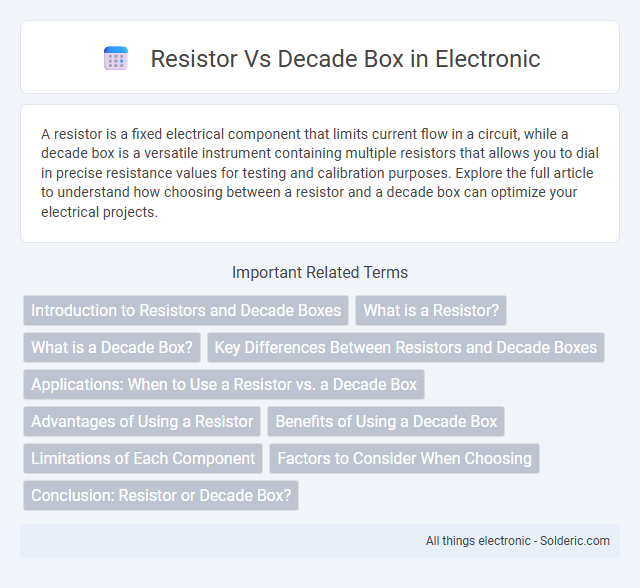A resistor is a fixed electrical component that limits current flow in a circuit, while a decade box is a versatile instrument containing multiple resistors that allows you to dial in precise resistance values for testing and calibration purposes. Explore the full article to understand how choosing between a resistor and a decade box can optimize your electrical projects.
Comparison Table
| Feature | Resistor | Decade Box |
|---|---|---|
| Purpose | Fixed resistance element | Adjustable resistance for testing and calibration |
| Resistance Range | Specific, fixed value | Wide range, selectable in decade steps |
| Adjustability | Non-adjustable | Adjustable via dials or switches |
| Applications | Circuit design, current limiting | Prototyping, circuit testing, calibration |
| Accuracy | Depends on tolerance (e.g., +-1%) | High accuracy with selectable values |
| Cost | Low | Higher due to mechanical components |
| Size | Small, discrete component | Bulkier, box form factor |
Introduction to Resistors and Decade Boxes
Resistors are fundamental electronic components that provide precise resistance to control current flow in circuits, available in fixed or variable values tailored for specific applications. A decade box is a versatile instrument containing multiple resistors arranged in selectable decades, enabling you to dial in a precise resistance value for testing and prototyping without physically swapping components. This makes decade boxes invaluable for experimenting with different resistance values quickly while resistors offer permanent and reliable performance in finalized designs.
What is a Resistor?
A resistor is a passive electrical component designed to limit or regulate the flow of electric current in a circuit by providing a specific amount of resistance, measured in ohms (O). It dissipates electrical energy as heat and is essential for controlling voltage and current within electronic devices. Unlike a decade box, which offers adjustable resistance values for testing and calibration, a resistor has a fixed resistance determined by its material composition and size.
What is a Decade Box?
A decade box is a precision testing instrument that allows you to select specific resistance values by dialing in decade increments, typically ranging from 1 ohm to several megaohms. Unlike a fixed resistor, a decade box offers adjustable resistance in standardized units, making it an essential tool for circuit calibration, troubleshooting, and educational purposes. Your use of a decade box simplifies experiments by providing quick, accurate resistance changes without the need for multiple discrete resistors.
Key Differences Between Resistors and Decade Boxes
Resistors are fixed components with a single resistance value, commonly used in electronic circuits for controlling current flow, while decade boxes are adjustable instruments containing multiple resistors that provide a range of precise resistance values by switching settings. Resistors are typically measured in ohms and characterized by parameters such as tolerance, power rating, and temperature coefficient, whereas decade boxes offer versatility and convenience for prototyping, testing, and calibration without physically replacing components. The fundamental difference lies in the fixed resistance of resistors versus the selectable resistance range of decade boxes, making the latter indispensable for experimental flexibility and circuit analysis.
Applications: When to Use a Resistor vs. a Decade Box
Resistors are essential for fixed, precise resistance applications like current limiting and voltage division in electronic circuits, where stable and predictable resistance is required. A decade box excels in testing, calibration, and prototyping by allowing you to quickly dial in various resistance values without swapping components. Your choice between a resistor and a decade box depends on whether you're developing a circuit with fixed parameters or performing flexible resistance testing and experimentation.
Advantages of Using a Resistor
A resistor offers precise and stable resistance values essential for consistent circuit performance and minimal signal distortion. By using a fixed resistor, you ensure reliable operation under specific current and voltage conditions without the need for adjustment. Your designs benefit from the simplicity, low cost, and durability of resistors compared to the adjustable complexity of a decade box.
Benefits of Using a Decade Box
A decade box offers precise and adjustable resistance values, enabling accurate circuit testing and calibration without the need to swap multiple resistors. It simplifies prototyping by providing a wide range of resistance options in a single compact device, reducing setup time and minimizing errors. Engineers and technicians benefit from its versatility in simulating real-world conditions and fine-tuning circuits efficiently compared to fixed-value resistors.
Limitations of Each Component
Resistors have fixed resistance values and can overheat or fail when exposed to currents beyond their rated capacity, limiting their flexibility in variable circuit applications. A decade box provides adjustable resistance through multiple switches, but it may introduce contact resistance and a slower adjustment process, which affects precision and speed in testing. Your choice depends on whether you prioritize exact fixed values with durability or variable control with potential minor accuracy trade-offs.
Factors to Consider When Choosing
When selecting between a resistor and a decade box, consider accuracy, flexibility, and application requirements. Resistors provide fixed, precise resistance values ideal for stable, single-value applications, while decade boxes offer adjustable resistance, enhancing versatility in prototyping and testing circuits. Your choice depends on whether you prioritize a permanent, consistent component or the ability to modify resistance dynamically during experimentation.
Conclusion: Resistor or Decade Box?
A resistor provides a fixed resistance value ideal for simple, low-cost applications, while a decade box offers adjustable resistance with high precision and versatility, making it suitable for prototyping and testing circuits. Engineers and technicians prefer decade boxes when flexibility and variable resistance are crucial, as they combine multiple resistors in a compact, easy-to-use format. Choosing between a resistor and a decade box depends on the specific needs of the project, whether static resistance or adjustable tuning is required.
resistor vs decade box Infographic

 solderic.com
solderic.com